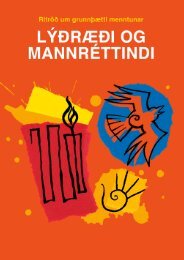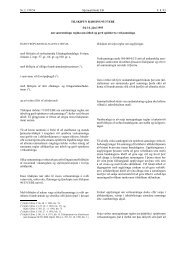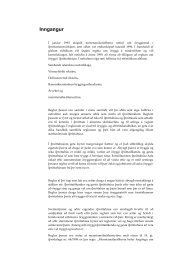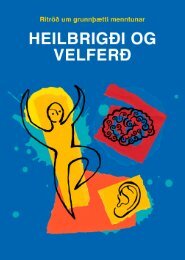Arts and Cultural Education in Iceland : Professor Anne Bamford
Arts and Cultural Education in Iceland : Professor Anne Bamford
Arts and Cultural Education in Iceland : Professor Anne Bamford
You also want an ePaper? Increase the reach of your titles
YUMPU automatically turns print PDFs into web optimized ePapers that Google loves.
schools have wait<strong>in</strong>g lists of children wish<strong>in</strong>g to start music lessons. This is especially the case <strong>in</strong><br />
the area of s<strong>in</strong>g<strong>in</strong>g <strong>and</strong> guitar, where dem<strong>and</strong> seems to be <strong>in</strong> excess of supply of teachers.<br />
Most music schools have developed their own pattern of offer<strong>in</strong>gs. These can <strong>in</strong>clude a<br />
range of <strong>in</strong>-school <strong>and</strong> out-of-school lessons. To accurately map these offer<strong>in</strong>gs is quite difficult<br />
as they not only vary from one school to the next, but also at different ages with<strong>in</strong> the school as<br />
the follow<strong>in</strong>g example highlights:<br />
In pre-primary school the children get one 30 m<strong>in</strong>ute lesson per week. The six year olds get 2 x 30 m<strong>in</strong>ute<br />
small group lessons per week. The seven year olds choose an <strong>in</strong>strument (e.g. accordion, piano, viol<strong>in</strong> <strong>and</strong><br />
guitar). The 8 year olds get one hour <strong>in</strong>dividual lesson. N<strong>in</strong>e year olds get 2 x 60 m<strong>in</strong>ute lessons. These<br />
lessons are all free. We provide African drumm<strong>in</strong>g lessons for n<strong>in</strong>e year olds <strong>and</strong> grade seven also get<br />
African music. These are whole class lessons given dur<strong>in</strong>g class time <strong>and</strong> are free. But pupils can also do<br />
additional music lessons that are <strong>in</strong>dividual <strong>and</strong> paid for by the parents. Grades eight to ten can choose a<br />
music elective <strong>and</strong> most pupils do choose it because music is very popular. Children can apply to the music<br />
school for private lessons <strong>and</strong> these can be done dur<strong>in</strong>g school time too, but for these they have to pay. It<br />
costs around 26,000 ISK for 18 weeks. This covers a one hour private lesson per week. In total we have 356<br />
pupils <strong>in</strong> the music school across all programmes. Of these, more than 50% of the students do additional<br />
private lessons.<br />
While historically, music schools have had little direct contact with schools, this pattern is<br />
chang<strong>in</strong>g. Many music schools are now work<strong>in</strong>g <strong>in</strong> very close collaboration with compulsory <strong>and</strong><br />
secondary schools <strong>and</strong> pupils are able to attend the music school dur<strong>in</strong>g school time. Staff from<br />
the music school may also teach group music classes <strong>and</strong> pre-<strong>in</strong>strumental lessons with<strong>in</strong> the<br />
general school. This is particularly the case for younger pupils. Specialist music teachers <strong>in</strong> the<br />
music schools are generally reluctant to teach <strong>in</strong> the compulsory school. They feel that “it is hard<br />
work <strong>and</strong> low salaries”. Many schools “lack the facilities” <strong>and</strong> do not “support the music<br />
teacher”. The follow<strong>in</strong>g quote from a teacher educator for music education <strong>in</strong> schools suggests<br />
that there are different tra<strong>in</strong><strong>in</strong>g requirements for class or group teachers <strong>in</strong> compulsory schools<br />
compared to those teach<strong>in</strong>g <strong>in</strong>dividual lessons <strong>in</strong> music school contexts:<br />
I th<strong>in</strong>k the music teacher education with<strong>in</strong> the education department is better for music teachers <strong>in</strong> the<br />
compulsory school. We teach them how to teach music <strong>in</strong> bigger groups <strong>and</strong> how to motivate students. We also<br />
talk about how to reach students from a range of abilities. I th<strong>in</strong>k music has changed a lot. But music education is<br />
still expensive – it is quite luxurious really. Students com<strong>in</strong>g from the conservatoire are not prepared to teach <strong>in</strong><br />
the classroom. There is a big difference between teach<strong>in</strong>g a private musical <strong>in</strong>strument lesson compared to<br />
communicat<strong>in</strong>g music to a whole class. Teachers need skills <strong>in</strong> evaluation <strong>and</strong> how to cope with a wider range of<br />
more varied types of students. Music needs to become more <strong>in</strong>tegrated <strong>in</strong>to the school. The arts subjects still<br />
rema<strong>in</strong> isolated. They have been the same for decades. The problem is, when we talk about ‘<strong>in</strong>tegrated arts’ then<br />
it is an excuse for everyth<strong>in</strong>g to be m<strong>in</strong>imised <strong>and</strong> then you can’t teach the skills. It is really frustrat<strong>in</strong>g. The<br />
common core gets reduced. Teach<strong>in</strong>g hours get reduced <strong>and</strong> then you can’t attract good teachers.<br />
A small number of music schools are physically based with<strong>in</strong> the compulsory school build<strong>in</strong>gs<br />
or site <strong>and</strong> pupils are able to move freely to their <strong>in</strong>strumental lessons <strong>in</strong> the music school. While<br />
this pattern has generally been well-received by all, some music school teachers have expressed<br />
concern that teach<strong>in</strong>g with<strong>in</strong> the general school is often poorly regarded with low levels of<br />
specialist equipment, isolation from peers <strong>and</strong> lack of genu<strong>in</strong>e <strong>in</strong>tegration with the general<br />
school context <strong>and</strong> staff. There is a desire for collaborations between regular schools <strong>and</strong> after<br />
schools with the <strong>in</strong>tention that closer l<strong>in</strong>ks would be mutually beneficial but there is also concern<br />
that the pattern of fund<strong>in</strong>g for such collaborations is unclear. Where music schools are work<strong>in</strong>g<br />
with<strong>in</strong> the compulsory school, they appear to f<strong>in</strong>d this way of work<strong>in</strong>g very reward<strong>in</strong>g with<br />
mutual benefits for all, as the follow<strong>in</strong>g vignette (1.12.7) from a music school embedded with<strong>in</strong> a<br />
compulsory school suggests:<br />
Vignette 1.12.7 A very positive effect on the culture of the compulsory school<br />
We are very lucky. This school was built around the pr<strong>in</strong>ciple that the library <strong>and</strong> the music school would be actually at<br />
the centre of the school.<br />
41



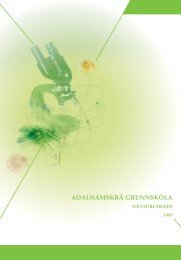
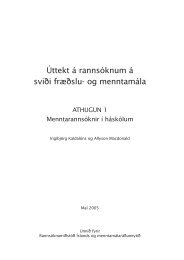

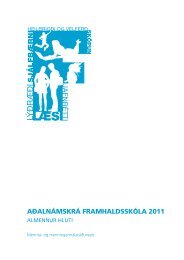
![Aðalnámskrá tónlistarskóla : rytmÃsk tónlist [Eingöngu á rafrænu formi]](https://img.yumpu.com/50843672/1/184x260/aaalnamskra-tanlistarskala-rytma-sk-tanlist-eingangu-a-rafranu-formi.jpg?quality=85)
